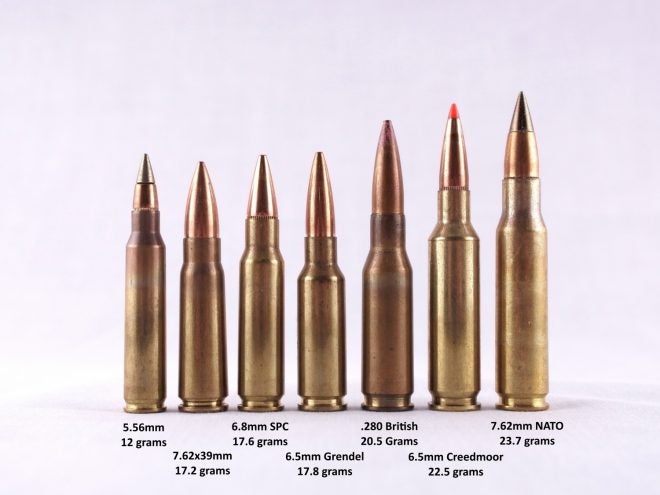We are at a crossroads in small arms development. Demands for improved weapon effectiveness have reached their apex. At the same time, the soldier’s burden has grown into a crisis so pressing even the Army Chief of Staff has acknowledged it in testimony to Congress. Soon the next ammunition configuration will be decided, as new technologies open the door for a rethinking of the infantry’s most basic weapons.
Whatever round they choose, it has to be light. Here’s why, in one simple example.
Since both the load of the soldier and round effectiveness are serious concerns for the next small arms configuration, perhaps the right answer is to split the difference and go with something directly in the middle. However, “in the middle” probably doesn’t mean what you think. I’ll explain.
Let’s assume two rounds: One weighs 10 grams, while the other weighs 20. Since the first round is half the weight of the second, a soldier can carry twice as much per kilogram. Let’s go ahead and express that mathematically:
1000 g / 10 g = 100
1000 g / 20 g = 50
If we want something “in the middle”, we need a round that allows the soldier to carry more rounds than the 20 g round, but we decide it’s probably OK if he can’t carry as many as the 10 g round. 75 rounds is right in the middle of 100 and 50, and we determine that would be satisfactory. Simple intuition tells us this round needs to weigh 15 grams to give us that combat load:
1000 g / 15 g = 66.66… !!!
That’s right, splitting the difference does not give us a combat load in between the two rounds, it gives us a combat load twice as close to the 20 g round as the 10 gram round! This case illustrates that our natural intuition with numbers is wrong, that in fact the halfway point is somewhere else:
1000 g / 75 = 13.33… g
So, paradoxically, the midway point for a given combat load between the two rounds is twice as close to the lighter round as the heavier!
To drive the point home, we’ll repeat the example with the masses of two real rounds: 5.56mm NATO and 7.62mm NATO. 5.56mm weighs about 12 grams per shot; 7.62mm about 24 grams. Keeping in mind that the average of 12 and 24 is 18, let’s see how the math shakes out:
1000 g / 12 g = 83.33…
1000 g / 24 g = 41.66…
1000 g / (83.33… + 41.66…)/2 = 16 grams
It’s counter-intuitive, but it’s simple math. The next round has to be light, because the halfway point isn’t where you think it is.
(For the math geeks in the room, you have already figured out that it is the harmonic mean you need to use for this problem, not the arithmetic mean. Since this is a family-friendly site, I omitted these terms to keep things understandable for everyone.)
 Your Privacy Choices
Your Privacy Choices
